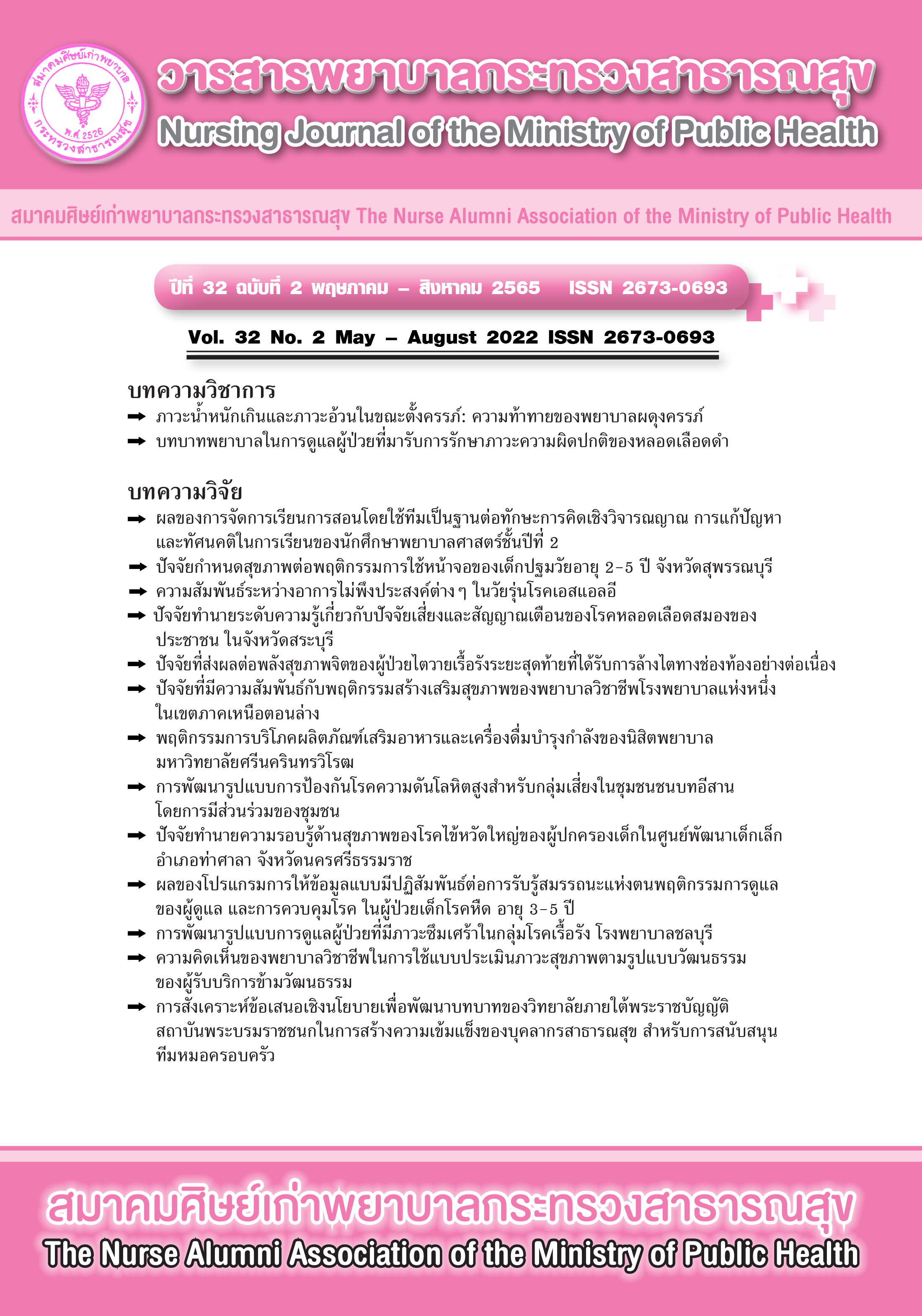Effects of Team-based Learning on Critical Thinking, Problem Solving Skills, and Attitudes Towards Learning in Second-year Nursing Students
Main Article Content
Abstract
The objectives of this quasi-experimental research with a one-group pretest-posttest design were to investigate the effects of Team-based Learning in Psychiatric Nursing II on 1) critical thinking, problem solving skills, 2) collaboration, teamwork and leadership skills, 3) communication, information and media literacy skills, and 4) attitude towards learning. The sample consisted of 62 second-year nursing students from Suranaree University of Technology. The measures used were 1) questionnaire assessing critical thinking, problem solving skills, collaboration, teamwork and leadership skills, communication, information and media literacy skills (CVI=.93, r=.924), and 2) attitudes towards learning questionnaire (CVI = .67, r = .913). Data were analysed using descriptive statistics, paired sample t-test, and content analysis. The results showed that critical thinking and problem-solving skills significantly increased after learning (t= 2.11, p=.039). Attitudes toward learning also increased significantly after learning (t = 4.265, p=.000). The samples reported that they were impressed with team-based learning. Therefore, instructors should apply team-based learning to other subjects to improve students’ skills.
Article Details

This work is licensed under a Creative Commons Attribution-NonCommercial-NoDerivatives 4.0 International License.
บทความและรายงานวิจัยในวารสารพยาบาลกระทรวงสาธารณสุข เป็นความคิดเห็นของ ผู้เขียน มิใช่ของคณะผู้จัดทำ และมิใช่ความรับผิดชอบของสมาคมศิษย์เก่าพยาบาลกระทรวงสาธารณสุข ซึ่งสามารถนำไปอ้างอิงได้
References
The Ministry of Education. Thailand Qualification Framework for Nursing Education 2017 [Internet]. 2017. Available from: http://www.mua.go.th/users/tqf-hed/news/data6/ประกาศ-ศธ-NQF-2560-พยาบาลศาสตร์-ป-ตรี.PDF
Pliankerd P, Kerdsiri S. The Competency of Psychiatric Nursing in the Practice of Nursing. J R Thai Army Nurses.2014;15(2):160–5.
Michaelsen LK, Sweet M. The essential elements of team-based learning. In: New Directions for Teaching and Learning. Wiley Periodicals, Inc.;2008.7–27.
Haidet P, Levine RE, Parmelee DX, Crow S, Kennedy F, Kelly PA, et al. Perspective: guidelines for reporting team-based learning activities in the medical and health sciences education literature. Acad Med. 2012;87(3):292–9.
Chen M, Ni C, Hu Y, Wang M, Liu L, Ji X, et al. Meta-analysis on the effectiveness of team-based learning on medical educaiton in China. BMC Med Educ. 2018;18(77):1–11.
Suk-Young L, Seung-Ju K. The Effects of Team-Based Learning Education on Critical Thinking, Interpersonal Relationships, Self-Leadership and Academic Major Satisfaction. Int J Elder Welf Promot Manag. 2020;4(1):7–14.
Considine J, Berry D, Allen J, Hewitt N, Oldland E, Sprogis SK, et al. Team-based learning in nursing education: a scoping review. J Clin Nurs. 2021 Apr;30(7–8):903–17.
Sirirat N, Chidnayee S. Effect of Team-based Learning in Nursing Care of Persons with Health Problems 1 on achievements and critical thinking in nursing students. J Heal Sci Res.2009;3(2):32–40.
Development of a Pedagogical Model to Promote 21st Century Skills of Nursing Students Boromarajonani College of Nursing , Chonburi Praboromarajchanok Institute Ministry of Public Health.
Dharmasaroja P. Dysfunctional Team-Based Learning. Ramathibodi Med J.2020;43(1):54–61.
Ulfa Y, Igarashi Y, Takahata K, Shishido E, Horiuchi S. Effectiveness of team-based learning on postpartum hemorrhage in midwifery students in Indonesia: A quasi-experimental study. Nurse Educ Today.2021; 105(June):105-15.
Bloom BS. Taxonomy of educational objectives, handbook I: The cognitive domain. New York: David McKay Co Inc.;1956.
Duron R, Limbach B, Waugh W. Critical thinking framework for any discipline. Int J Teach Learn High Educ. 2006;17(2):160–6.
Phoyen K. Active Learning in 21St Century Pedagogy. J Educ Silpakorn Univ.2021;19(1):11–28.
Panich W. Teacher for students: Creating flipped classroom. 2nd ed. Kittkorn R, editor. Bangkok: SR Printing Mass Products, Ltd.;2013:119.
Thangthum W, Thiengtrongdee A. Effects of Team-Based Learning on Knowledge and Teamwork Perception of Nursing Students. Multidiscip J Heal.2019;1(1):1–9.
Garin O. Ceiling Effect. In: Michalos AC, editor. Encyclopedia of Quality of Life and Well-Being Research. Dordrecht: Springer Netherlands;2014:631–3.
Huitt TW, Killins A, Brooks WS. Team-based learning in the gross anatomy laboratory improves academic performance and students’ attitudes toward teamwork. Anat Sci Educ.2015;8(2):95–103.
Sawangtook S, Panthongchai S, Polprasarn P. The Teaching Experience with Flipped Classroom in Nursing Care during the Second Stage of Labour.2019;26(2):145–55.

